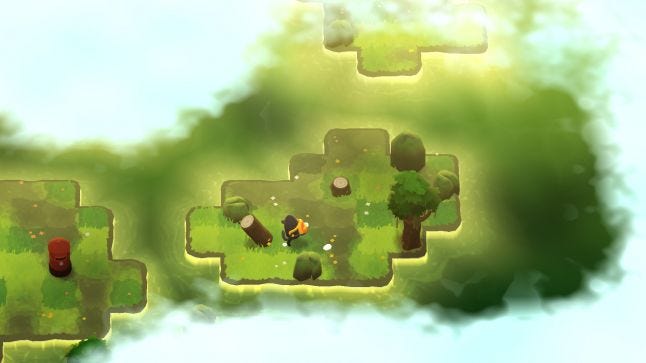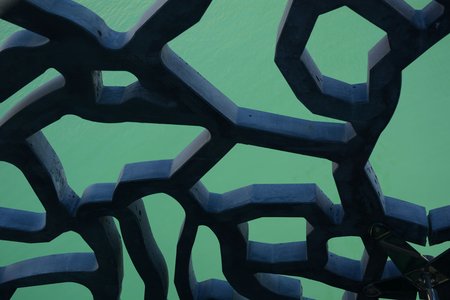This interview is part of our Road to the IGF series.
A Monster's Expedition, nominated for Excellence in Audio and Design in this year's IGF, helps monsters learn about humans as they explore an array of islands by completing log-pushing puzzles along the way.
Gamasutra sat down with the team behind the game to discuss how the game's charming narrative slowly came together, the thoughts that go into creating interesting puzzles, and the careful crafting that went into maintaining the game's calming mood.
Who are you, and what was your role in developing A Monster's Expedition?
deGrandis: I'm Adam deGrandis and I was the art director for A Monster's Expedition.
I've been working in games since 2004. Over those years, I've worked on close to 80 titles, with about half of them actually shipping. Now I run a visual design and art production studio called Chickadee, which caters to the indie community.
Hazelden: I'm Alan Hazelden and I was the creative director and lead puzzle designer for A Monster's Expedition.
I started taking part in game jams in 2006 and made small/bad/funny games for a while, and since 2010 have been mostly focused on making puzzle games. In 2013 I quit my web development job to make video games full time. I expected I'd run out of savings in a year or two, but somehow that hasn't happened yet! Since then, I've released some well-received puzzle games like Sokobond, A Good Snowman Is Hard To Build, Cosmic Express, and A Monster's Expedition, as well as several smaller free games mostly made in the excellent game-making tool PuzzleScript.
Davis: I’m Benjamin Davis. I was the lead programmer for A Monster’s Expedition, but also worked in different areas, most notably co-designing the original prototype and animating all of the log and raft interactions.
I released one commercially unsuccessful game on my own before teaming up with Alan for A Good Snowman Is Hard To Build, Cosmic Express, and then A Monster’s Expedition. I’ve also been making terrible small games on-and-off as a hobby for over twenty years now, though these days I prefer to try new and different things during my spare time.
Rainsberry: My name is Eli Rainsberry, and I'm a composer and sound artist. My role in developing A Monster's Expedition was designing audio, which involved collaborating with the team to establish initial ideas and concepts for its sound design and music system. I specifically worked with Alan to establish placements of music themes and establish direction on a number of sounds made, and with Ben to create sound hooks for every individual audio asset. As a result, we developed a dynamic system which takes inspiration from the pieces of music that play when you set foot on different islands.
I've been making music and sounds for games over the last four to five years, with my first release for console being Wilmot's Warehouse. As well as A Monster's Exhibition, I've since worked on audio for Bird Alone, If Found..., and the upcoming game No Longer Home. I've come from a background of initially composing for short films and animations, as well as some interdisciplinary work, and found my way into games by getting myself more involved in the smaller communities of game makers and game-adjacent creatives.
Warr: My name is Philippa Warr. I was the writer/narrative designer on A Monster's Expedition.
I'd dabbled a little prior to A Monster's Expedition. For example, I edited the text for the deckbuilding roguelike Dicey Dungeons (and contributed a little to the writing in the process). Other than that, I've spent more than a decade as a critic and writer in the entertainment industry.
McNulty: I’m Syrenne McNulty and I was the producer of the game, guiding it through the last year of development to release, and have been working on post-release patches and updates ever since!
I worked on a few small titles of my own before realizing I was most comfortable with the production and release management side of things, so I started working with teams in a freelance capacity to do exactly that. I’m currently working on about a dozen releases, depending on how you count things, and am very happy.

How did you come up with the concept for A Monster's Expedition?

Davis: We had just released Cosmic Express and we wanted to pitch a new game for a competition. I really liked Alan’s island-themed PuzzleScript games (especially Skipping Stones to Lonely Homes) and wanted to make something similar. I started playing around with mechanics for cutting down trees and flipping them over, but it wasn’t really going anywhere. Alan took a look and came up with the idea that they should roll until they stop against something, and it turned out to be just the thing we needed. I came back to him with a dozen or so puzzles. We developed the rest of the mechanics together while Alan dove into his iterative process of level design and play testing.
What development tools were used to build your game?
Davis: The original prototype was written in PuzzleScript, which is a very specialized tool for quickly making block-pushing puzzle games. Once we had a solid idea of the mechanics, I ported the logic to Unity and wrote an importer for the PuzzleScript level format while Alan continued designing levels. By the end of the project, we’d developed several in-engine tools for level design, arranging, testing and more.
deGrandis: The art pipelines were pretty straightforward - Blender for 3d assets, Photoshop for 2d, and our shaders were authored in Amplify Shader Editor.
What interested you in making an open world filled with puzzles? In letting players choose where to go to challenge themselves?
Davis: There’s a specific feeling you get from exploring an adventure game. The nervous excitement from cresting a new hill to view the plateau below. The trepidation over what lies in the cave deep in the forest. The relief from reaching a village safe from the wilds. I don’t think we were very successful at instilling this, but for good reason. A Monster’s Expedition is first-and-foremost a puzzle game, so all the systems need to either work to remove friction from interacting with the puzzles or to provide rest.
The camera is one area that severely constrained our ability to create surprises and add mystery. We very much need to provide a good overview of the puzzle at-hand, as well as make it easy to read the grid. This means no big forest obscuring your view until an opportune moment. No torchlit, third-person climb to the summit to watch the sunrise as the world opens up before you.
Having said all that, the team did a great job of taking advantage of the open world. Multiple paths to take means that if you’re stuck on one puzzle, there’s usually another elsewhere that you can try instead. And that windmill over there? I bet you’d like to check that out. We were able to provide visual clues about which way to go, and use the exhibits as incentives to lead you down different paths.
It took us a long time to abandon the pursuit of this “feeling of exploration” and really focus down on what the core experience should be. It turns out that sometimes you just need to get out of the player’s way, and then put in a reverse mermaid, and an emergency cheese sandwich, and a neat little collection of leach-powered technology.

What inspired the story of monsters learning about humans? What drew you to this narrative?
Warr: When the team came to talk to me about the project, their idea was that there would be some kind of collection of objects spread across the islands of the game. At the time, they were leaning towards all the objects being "lost" in some capacity, and the space being some kind of cosmic repository. Alan used the phrase "Museum at the End of Time" to refer to the collection, so I started to experiment with sets of themed object descriptions written as museum placards. I've done some museum work in the past, so it was handy to be able to draw on that. In case you're curious, the placards were initially a lot more detailed, with fields for dates, materials, catalogue numbers, locations etc. Those were really interesting places to hide jokes, but ultimately we cut them down for ease of presentation.
The descriptions of the objects were always a bit weird because I was always imagining that the curator (whoever we settled on) would be missing vital context. The team really liked that humour, so I used the unreliable narrator/curator as a starting point for exploring ideas.
Narrowing down what kind of museum we should have, and who the player character would be, was a far longer process! A lot of work had already been done on building the game and making assets, so I needed to create a narrative that felt right AND wasn't in conflict with existing elements. I remember a very energetic conversation about whether we could (or should) use a staff room as a save point! We even considered getting rid of the museum idea entirely at one juncture and I drafted a whole other narrative plan, just in case.
Ultimately, everything felt like it was really falling into place when the monsters became the main inhabitants of this universe. You might remember the monster character from one of the older Draknek games: A Good Snowman Is Hard To Build. They're basically a black gumdrop with legs, and they're adorable, just exploring the game's world and gently engaging with everything they encounter. Putting them in A Monster's Expedition immediately gelled with the sense of childlike interest I wanted, both in terms of how the player explored the environment through them, and in terms of how they might describe human artifacts.
Hazelden: The world of the game took a long time to come together. For a long time, we were trying to make something with more of a story/narrative - something that might feel like a quest where you’re traveling through strange lands and meeting strange characters. We went through a lot of ideas that didn’t end up fitting the game; we started over probably half a dozen times over the course of development. The “place of lost things” Pip refers to was an idea from our former narrative designer Hannah Nicklin that, at the time, didn’t get much further than being an evocative phrase, but the final time we came to tear up the narrative and build something new, it mutated into the idea of a museum which turned out to be a great fit for the game.
What thoughts go into designing puzzles around pushing logs? Can you walk us through the creation process of one of the puzzles?
Hazelden: Generally, the starting point is choosing a single interaction, or chain of interactions, that I want you to have to do as part of the solution - something that I think is an interesting consequence of the mechanics.
For the memorable puzzle just before the windmill, what this meant is that I needed to design a puzzle which A) forces you to form a raft in a specific spot, B) makes you think you have to leave by getting a log to a particular place, C) makes you realise that the only way to get that log there would be to push it upwards from the raft, and then D) surprises you.
After establishing what I’m trying to make, it’s often fairly quick to make a first draft of the level; I’ll just place the gameplay elements in such a way that works for the solution in my head. Then, there’s an iteration process where I play the level and try to find what else I can do that’s not that - if it’s possible to bypass the intended solution then I’ll iterate to prevent that being possible, but by blocking the unexpected solution I might accidentally make the level impossible, and then resolving that might cause another problem - essentially it’s a game of whack a mole. A single puzzle can take anywhere from a few minutes to many hours to iterate on until I find a version I’m happy with (for some puzzles, many hours across many years).
Along the way, I’ll often have made several levels with different versions of the idea, and also several levels where an unintended solution I found was interesting enough in its own right to be made into its own puzzle. In that way, I might start with one specific interaction in mind at the start of a design session and get a dozen or more puzzles out of it - but then of those we’ll only use the one or two most interesting versions (Or sometimes they’ll all get cut - there’s only so much space in the museum!).
This sounds like a lot of work, but in some ways this was actually the easy part! Because of the open world nature of the game, where solving a puzzle on one island gives you access to another island with a different puzzle, the position of islands relative to one another is very important. Putting two puzzles too close together might break them or be misleading about where you’re trying to go, and some puzzles aren’t isolated to a single island. So, making a single change to fix one small problem on one island can ripple across a whole area. It’s maybe the hardest jigsaw puzzle in the world, but tremendously satisfying when an archipelago comes together.

What challenges go into creating a world that's relaxing when filling it with brain-busting puzzles? How did you maintain a sense of calm throughout A Monster's Expedition
No tags.



































